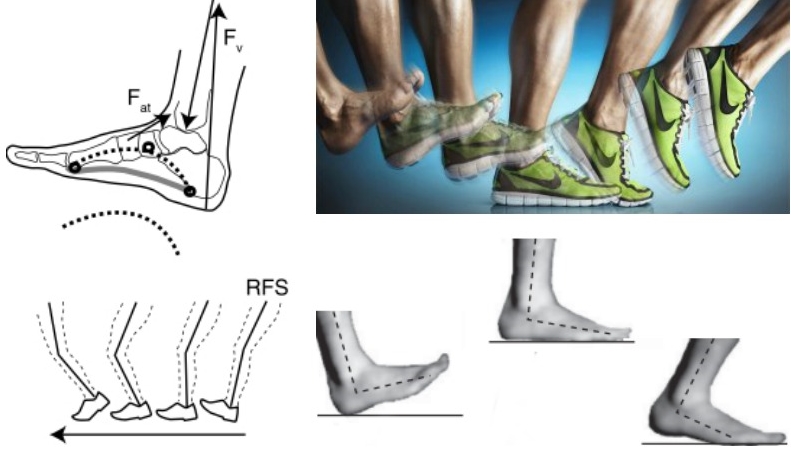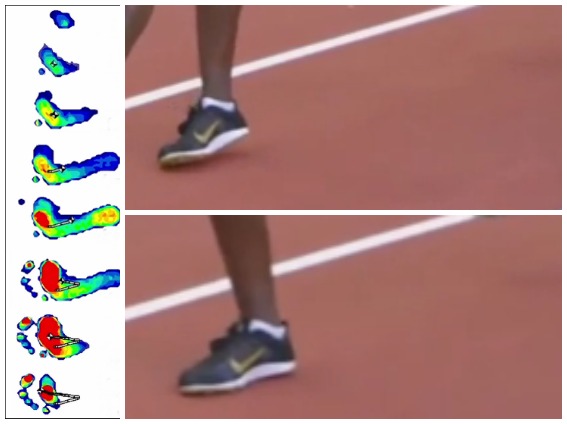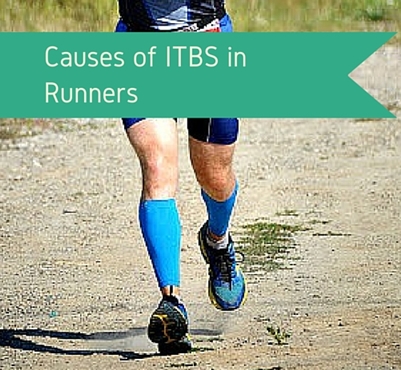Many runners experience tendon pain on the outer side of the knee (also known as IT Band Syndrome). One of the main causes of IT Band Syndrome in runners is influenced by the foot rollover component –where the foot rolls over the heel and on to the toes– of heel strike running.
Causes of IT Band Syndrome in Runners
To look at how the foot motions in a heel strike landing contributes to IT Band Syndrome, Grau et al. [1] compared foot rollover patterns in healthy runners to runners with IT Band Syndrome and found that the runners with IT Band Syndrome had a more lateral rollover pattern with emphasized supination at toe-off shortly after heel strike.

Because foot rollover is a biomechanical component of heel strike running suggests that heel strike running predisposes a runner to IT Band Syndrome.
Luckily, you can avoid unwanted foot motions from foot rollover with forefoot running.
Finding Help with Forefoot Running
The motions of the foot in forefoot running (shown below) does not involve a rollover pattern. A forefoot strike is actually the reverse of a heel strike because the foot is supinated at touchdown.
After touchdown on the forefoot, the foot dorsiflexes and everts when the heel lowers to the ground.

The center of mass also travels a shorter distance over the foot because initial foot strike position is close to the body in a forefoot strike [2], resulting in less ground interaction time and a more rapid removal of the foot compared to heel strike running.
Because of the quick interaction between the foot and the ground, a forefoot strike seems to mount much stronger control over abnormal rearfoot movements implicated in IT Band Syndrome.
The take home message is that adopting a forefoot strike landing may be the best way a heel strike runner can get rid of their IT Band Syndrome. To find out what a forefoot strike looks, click here to see!
More From Run Forefoot:
Barefoot Running – Are you having trouble with your forefoot running form? Running barefoot is the best and quickest way to polish your running style.
Energy Gels – Turn your body into a powerhouse with these endurance running gels.
Heel Strike Running – Need more convincing that heel striking is bad? If so, then reading these articles will make you think twice about heel striking.
Forefoot Running Shoes – Here are the shoes I feel are best for forefoot running!
Heel Strike vs Forefoot Strike – Find out more about the differences between the two running styles.
References:
[1]. Grau et al. Pattern recognition of ITB overuse injuries in running. J Biomech, 2006; 39 (Suppl 1).
[2]. Perl DP., Daoud AI and Lieberman DE. Effects of footwear and strike type on running economy. Med Sci Sports Exerc, 2012;44(7):1335-43.
Bretta Riches
BSc Neurobiology; MSc Biomechanics candidate, ultra minimalist runner & founder of RunForefoot. I was a heel striker, always injured. I was inspired by the great Tirunesh Dibaba to try forefoot running. Now, I'm injury free. This is why I launched Run Forefoot, to advocate the health & performance benefits of forefoot running and to raise awareness on the dangers of heel striking, because the world needs to know.
Latest posts by Bretta Riches (see all)
- Are Minimalist Shoes Good for Seniors? YES! - 14/04/2024
- BIG Deals On Running Gear And More! - 09/04/2024
- Why Are My Feet Tired After Running? - 04/04/2024


Leave a Reply